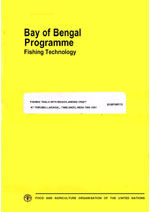
WORKING PAPERS - BOBP/WP/75
Fishing Trials with Beachlanding Craft at Thirumullaivasal, Tamil Nadu, India 1989-1991
by
O. Pajot
Sr. Fishing Technologist, BOBP
C.R. Prabhakaradu
Inspector of Fisheries, Tamil Nadu
 |
WORKING PAPERS - BOBP/WP/75 Fishing Trials with Beachlanding Craft at Thirumullaivasal, Tamil Nadu, India 1989-1991by |
|
Executing Agency: FOOD AND AGRICULTURE ORGANIZATION OF THE UNITED NATIONS Bay of Bengal Programme Madras, India, 1992 |
| The designations employed and the presentation of material in this publication do not imply the expression of any opinion whatsoever on the part of the Food and Agriculture Organization of the United Nations concerning the legal status of any country, territory, city or area or of its authorities, or concerning the delimitation of its frontiers or boundaries. |
All rights reserved. Reproduction and dissemination of material in this information product for educational or other non-commercial purposes are authorized without any prior written permission from the copyright holders provided the source is fully acknowledged. Reproduction of material in this information product for resale or other commercial purposes is prohibited without written permission of the copyright holders. Applications for such permission should be addressed to the Chief, Publishing and Multimedia Service, Information Division, FAO, Viale delle Terme di Caracalla, 00100 Rome, Italy or by email to [email protected]
© FAO 2004
|
Based on the experience gained in small-scale offshore fishing in Uppada, Andhra Pradesh, India (BOBP/WP/56), and the need to diversify and develop smallscale fisheries in the offshore areas off the Commanded Coast of Tamil Nadu, India, a subproject for the commercial fishing of pelagic species was established in 1989 by the Fisheries Department of Tamil Nadu with technical and financial support from the Bay of Bengal Programme. It was executed in Thirumullaivasal, Thanjavur District, from February 1989 to January 1991 with one beach landing craft (BLC) of the IND-20 type. A second boat of the same type became available in July 1990. The purpose of the subproject was to demonstrate to fisherfolk and Fisheries Officers the technical and economic feasibility of small-scale offshore fishing by using the BLC and employing diversified fishing gear. It was hoped that the demonstration would lead to commercial exploitation of less exploited resources and produce new sources of earnings for the fisherfolk who own and operate traditional as well as other introduced motorized fishing craft. This paper records the trials over a two-year period and the conclusions drawn from them. |
1. INTRODUCTION
2. SELECTION OF FISHING VILLAGE
3. THE CREW
4. FISHING GEAR AND THEIR OPERATIONS
4.1 Driftnetting and drift longlining for large pelagic species
4.2 Gillnetting for large Flyingfish
4.3 Gillnetting for small Flyingfish
5. FISHING CRAFT
6. OPERATIONAL ARRANGEMENTS
7. FISHING RESULTS
7.1 Sea time
7.2 Fishing effort
7.3 Catches
7.4 Catch rates
8. ECONOMIC PERFORMANCE
TABLES
1. Reasons for not going fishing (days)
2. Fishing effort by gear (days)
3. Catches by gear (kg and IRs*)
4. Catch rates by fishing gear (kg and Rs/day)
5. Seasonal variation of catch rate by fishing gear (kg/day)
6. Species composition by weight (kg) and value (Rs)
7. Costs and earnings data for two years (Rs)
8. Investment and depreciation
FIGURES
1. Map of coastal area showing operational base and fishing area
2. Driftnet
3. Drift longlines (Shark)
4. Gillnet (for large Flyingfish)
5. Gillnet (for small Flyingfish)
6. The FRP beachlanding craft IND-20
7. Steel winch
APPENDIX
I. Profile of Thirumullaivasal village
PUBLICATIONS OF THE BAY OF BENGAL PROGRAMME